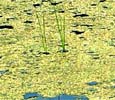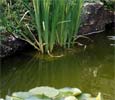When fish are stressed, they become susceptible to disease and sickness. Water quality can affect the health of fish and other aquatic life. Temperature, low oxygen, pH level, excess ammonia and nitrites affect water quality. Rapid temperature changes, spawning and rough handling will also stress fish. The application of herbicides, lawn & garden fertilizers and pesticides nearby can lower water quality and even kill fish.
Signs of fish problems:
Gasping at surface: usually indicative of low oxygen levels, often in humid weather. May also indicate that there are too many fish for the pond capacity. To solve this problem keep your pump running, especially at night when oxygen levels are at there lowest.
Lethargy/inactivity: indicative of poor water quality which may have many causes. OVERCROWDING and OVERFEEDING will lower water quality by increasing ammonia and nitrite levels. Also, chemicals from spraying your lawn and gardens can enter the pond, causing inactivity and even death. We recommend testing your water for excess amounts of ammonia and nitrites. If ammonia and nitrites are high, do a partial water change. Drain 1/3 of the pond’s water and replace it slowly using fine nozzle spray from a garden hose. Then add a water treatment to neutralize the water (see Pond Water Treatments). Repeat in 4-5 days. The use of biofilter (see Filters & UV Clarifiers), particularly when Koi are present, will greatly reduce problems associated with water quality. Bacteria in the biofilter will rapidly convert ammonia and nitrites into harmless nitrates.
Fungus, Tail Rot, White Spots: often occur when fish are stressed. First identify the disease and then treat with an appropriate medication (see Fish Medication)

Severe algae problem

Green water
CONTRIBUTING FACTORS
- Sunlight – when plant growth is not yet sufficient to provide shade
- Warm Water – resulting from inadequate plant cover and/or shallow water
- Dissolved Nutrients – present in the water, providing food upon which the algae thrives
- A Large Fish Population – fish waste is eventually broken down into nitrate fertilizer
- Excessive Feeding of Fish – unconsumed fish food and excess fish waste
RECOMMENDATIONS
Be Patient!!! Allow the pond time to achieve a natural ecological balance between plant life, nutrients, light and temperature. Once the plants start to grow, they will filter the sunlight; thus providing shade and lowering water temperature. In addition, these plants will consume excess nutrients in the water, thus depriving the algae of food or use a biofilter.
Do Not Change the Water. This merely provides a fresh supply of dissolved minerals for the algae to feed upon, and thus prolongs the time for a natural clearing to take place. Further, sudden temperature changes place stress upon the plants as well as fish.
Do Not Add Algaecides. This will create artificially clear water, which may become green again as chemicals lose their effectiveness. Most important, any chemical that will kill algae, a simple form of plant life, is likely to hinder the growth of more desirable aquatics such as lilies and marginal plants. Improper dosage can result in the loss of all plants and even fish. If coagulants are used to settle suspended algae, filtration is usually necessary to remove the coagulated plant material before its decomposition can harm fish.
String Algae. String algae is sometimes a problem in mature, balanced ponds with clear water. A small amount is beneficial in keeping the water clear and providing natural food for the fish. Excessive amounts can be removed manually or by gently altering the pond chemistry to create conditions unfavourable to the growth of string algae. Barley straw and peat pellets are natural products recommended for this purpose (see Natural Solutions in Pond Water Treatments). Stubborn, persistent growth may require the repeated application of Pond Balance. Be sure to follow directions carefully and remove organic debris by filtration or vacuuming.
Be Sure You Have Sufficient Plants for a Balanced Pond. Oxygenating plants do a great deal to absorb dissolved nutrients. We recommend 1 bag per 5-6 square feet of exposed surface area. Larger, deeper ponds require less. Allow for growth.
Add water hyacinths or another lily to provide shade and use up nutrients. Hyacinths are inexpensive and usually multiply rapidly. Other floating plants such as salvinia and duckweed are also very helpful.
A good supply of snails and/or vacuum will help to remove slime and accumulated debris, thus helping to keep the water clear. If fish population is large, especially Koi, a biofilter may be needed (see Filters & UV Clarifiers). We firmly believe that an ecologically balanced pond will provide more profuse growth and bloom, thus giving the water gardener more pleasure and satisfaction for his efforts. “Plant for balance”, be patient and prepare to sit back and enjoy a summer full of healthy, exotic flowers and lively fish.
- The use of chemicals in the pool to control algae is not recommended
- Planting containers are too small
- Lilies are not getting enough sunlight (need 6 hours minimum)
- When planting did not use heavy top soil and/or fertilizer as recommended
- Many commercially packaged soil mixtures are not suitable for good growth
- Is there soil or gravel on the crown of the plant?
- Needs fertilizer – did not fertilize monthly or as directed
- Root-bound (hardy lilies need dividing every two or three years)
- Too much or too little water over the crown of the plant
- Hardy lilies start to go dormant in September
- Tropical lilies do poorly in cold water and go dormant after heavy frost
- Use of herbicides or pesticides in your yard or the neighbour’s
- Splashing or turbulence from nearby fountain or waterfall
- Large Koi or Goldfish may be eating new growth and possibly disturbing the root system
- Excess of aphids, which may be sprayed off with hose, and eaten by fish





